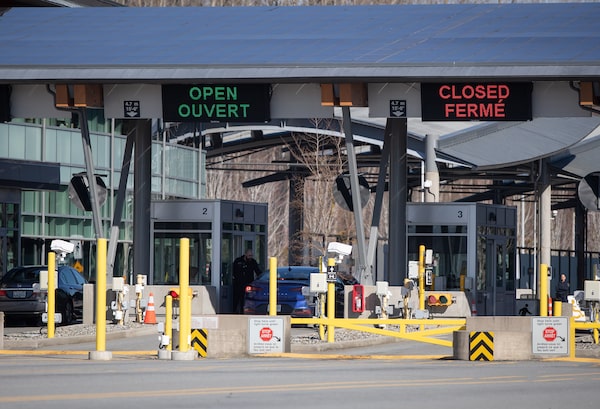
A Canada Border Services Agency officer speaks to a motorist entering Canada at a very quiet Douglas-Peace Arch border crossing, amid concerns about the spread of the coronavirus in Surrey, B.C., on March 18, 2020.DARRYL DYCK/The Canadian Press
Prime Minister Justin Trudeau says he would consider stricter border measures with the United States depending on the evolving situation there with respect to the coronavirus pandemic.
But given that the epicentre of the disease has now moved to U.S. shores, one wonders how much longer the federal government can wait before imposing even stronger sanctions at our border to safeguard the health of all Canadians.
Without a doubt, closing the border to all non-essential travel on Mar. 21 has had a huge impact, according to the latest figures from Canada Border Services Agency.
During the week of Mar. 23 to 29, for instance, the number of people coming into Canada from the U.S. over land was down 82 per cent, and nearly 85 per cent lower at airports, compared to the same time last year, according to a report that the CBSA provided me.
However, in that same week, more than 88,000 truck drivers from the U.S. were allowed into the country, along with nearly 100,000 “other travelers” – a group I suspect largely consisted of Canadian snowbirds returning from sunny southern getaways. I would expect that number will decrease dramatically in the coming weeks.
But that still leaves us with 88,000 truck drivers, which is, by the way, a decrease of nearly 24 per cent from the same week a year earlier.
We all understand and accept that the movement of goods between Canada and the U.S. is vital. These trucks supply us with fruits and vegetables, among many other types of goods and supplies. Shutting off the border to this traffic is not an option.
But if a country is only as strong as its weakest link in its fight against COVID-19, what does one do about tens of thousands of people arriving from a country that has now become ground zero of the pandemic?
The government has now ordered, by law, all Canadians returning home via the U.S. to quarantine for 14 days. This is being done for a very good reason. Unfortunately, the options at the government’s disposal regarding trucks coming into the country are not many, nor particularly attractive.
Border agents are asking drivers basic questions about the state of their health, while looking for any signs that the driver might be suffering from the virus. But given the high estimated numbers of asymptomatic cases, this is a very hit-or-miss process.
Some countries are using infrared guns to take the temperature of travelers arriving for entry. But experts have questioned the accuracy of these devices. Many jurisdictions have decided they’d do more harm than good.
Hong Kong, meanwhile, has taken what many consider fairly draconian measures when it comes to people returning there from another destination. They are made to wear tracking bracelets, which allows their movements to be monitored by a smartphone app. This is to ensure they abide by the terms of the 14-day quarantine they are put under after they return home from out of country.
The city of Denver has experimented with drive-through testing stations. They proved so popular they had to be shut down. But they show that the technology exists to provide testing that can produce quick results, in about 15 minutes.
I’m not sure how truck drivers from the United States would feel about any of these measures. I’m certain none would welcome tracking bracelets that monitor their activities inside our country, and some would surely resent a health worker sticking a giant Q-tip down their throat or up their nose. On the other hand, given the lack of testing in many parts of the U.S., some might actually welcome it.
But if we’re going to try and seal off all portals from which the virus can gain entry into Canada, I don’t know how we can’t look at the traffic that continues to come into our country from the U.S. The government can put its citizens in quarantine and self-isolation, but if we have infected people regularly coming into Canada from the U.S., efforts by citizens here to defeat the virus’s spread are going to be undermined.
Mr. Trudeau, his deputy Chrystia Freeland, and Treasury Board President Jean-Yves Duclos have all hinted at “further restrictions” at the border if the COVID-19 situation in the U.S. continued to spread rapidly. They have not indicated what they might be.
Mr. Duclos told Maclean’s magazine recently that while the work of truck drivers from the U.S. is important, “the health and security of Canadians is the most important.”
Hard to argue with that. The question now: How far will the federal government go to uphold that statement?
Keep your Opinions sharp and informed. Get the Opinion newsletter. Sign up today.